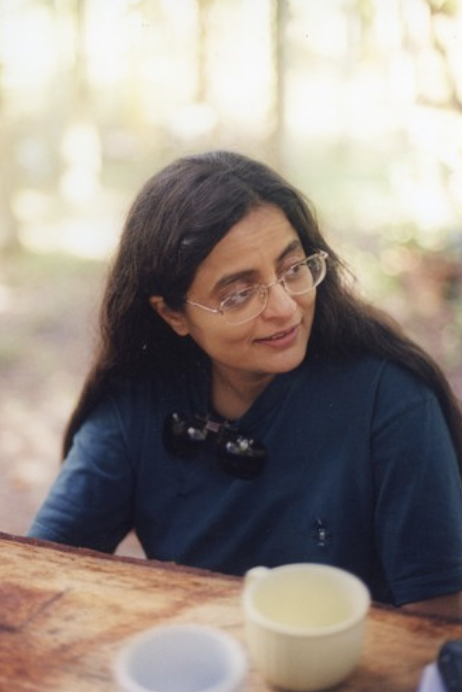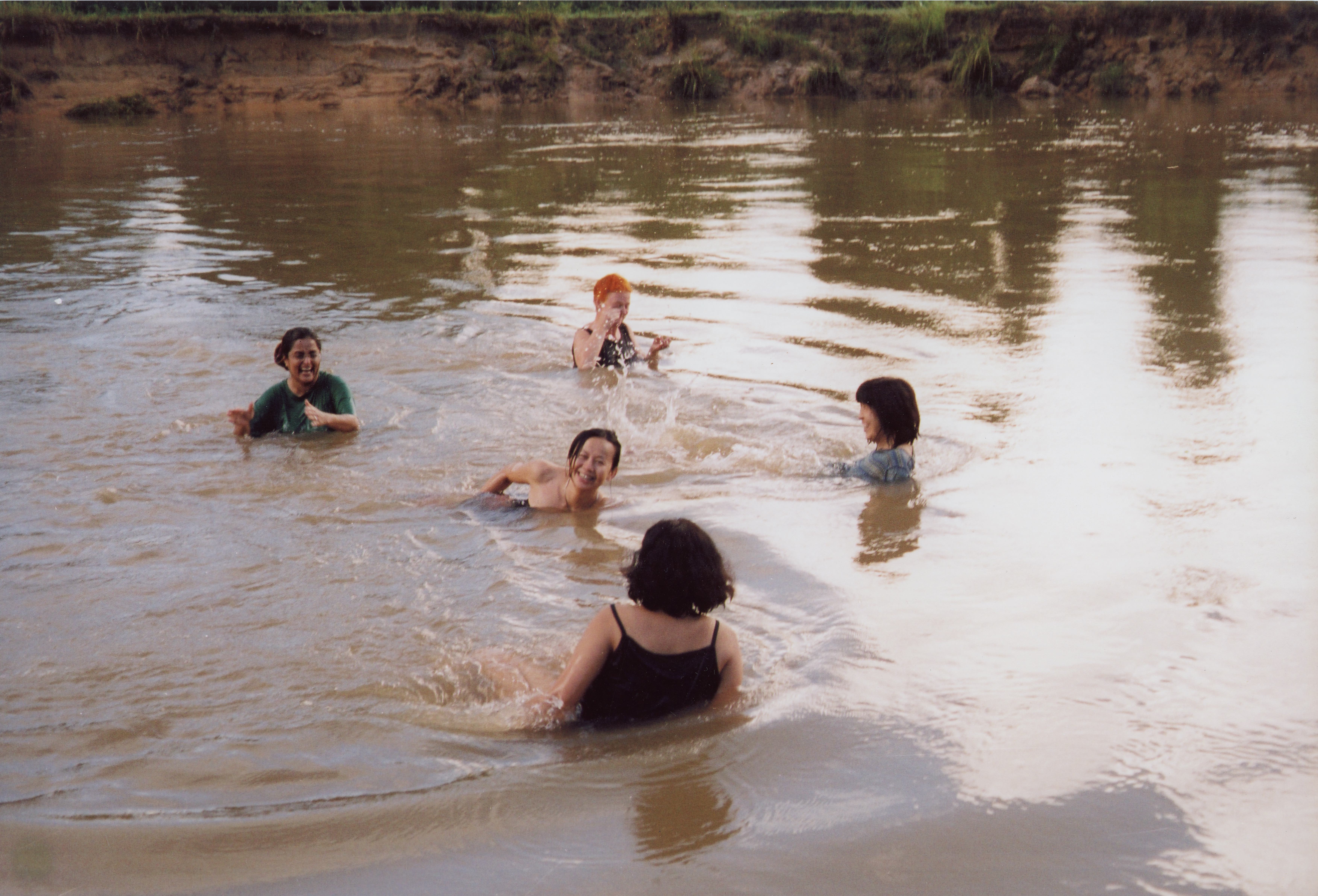By Nilofar Akmut
Please note that this publication is currently under review and will be subject to changes.
Setting up a workshop in a rural community Kantharaluk would not have been possible without the intimate knowledge forged through Pann Parahom’s connections with Boon Bandarn Farm. Pann, a yarn dyer and weaver, has a long established a working relationship with local communities across adjoining villages.
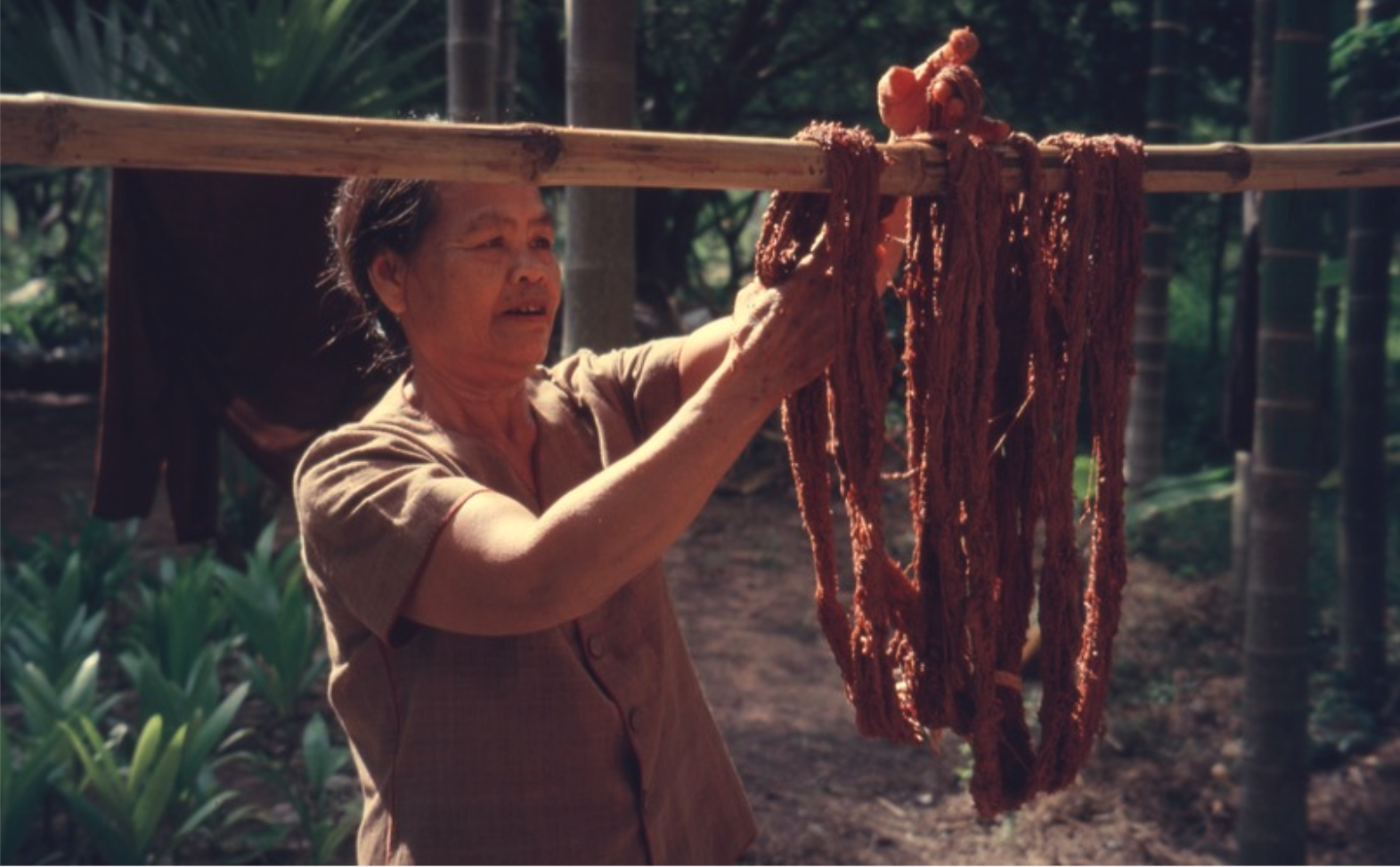
Pann Parahom is a dyer of yarn and weaver who wove on a floor loom. She was to become the future mother-in-law of one of the organisers, Nitaya Ueareewokul, a trained artist of this event. Pann Parahom’s energetic nature drew these two personalities together for a common cause.
Pann Parahom’s energetic nature drew her into collaboration over common causes with Nitaya Ueareewokul—a trained artist, and one of the organisers of this workshop—who was also soon to be Pann’s daughter in law.
Through Pann’s history with Womanifesto, and her ties to rural artisan communities in Thailand, a group of local craftspeople and an international group of artists had the experience of a unique collaboration. This event was constructed anthropology: trained artists arrived on a farm where local craftspeople were shipped in, rather than the artist arriving in the craftspeople’s original rural or village setting and living amongst them.
These practicing artists came together, not with a brief of having to create any work, rather the environment of a working farm, with its setting of individual huts specially created for the artists, a stream to swim in, flat farmland and the usual run of farm animals crating an idyllic setting to draw inspiration from.

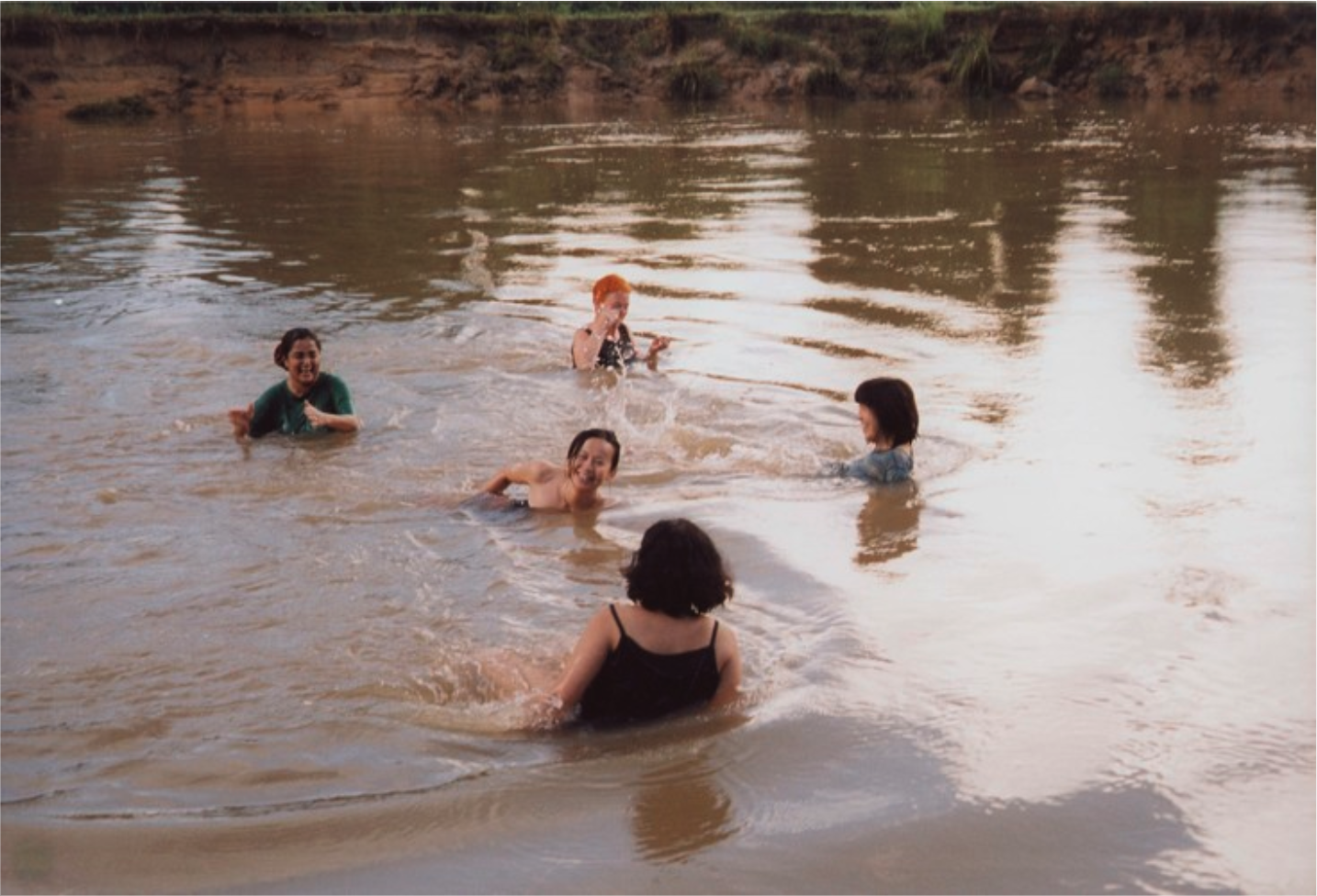
Two diametrically opposed methodologies and approaches towards the relationship between art and craft clashed – something often mistakenly construed as untenable. With the artisans adept at creating art the marries into practical day-to-day use, while the artists approached material with favour towards the art itself. What followed in this laboratory was to prove the role cultural clash plays in improving art.
We approached the craftpeople’s practices of cutting, dying yarn, loom-weaving, and basket-weaving with apprehension and some awe, however, exposure and interaction with the methods of the craftpeople seduced the visiting artists into working with all but one—Yin Xiuzhen. Yin Xiuzhen took her brief literally and did no artwork as such. Like a forest spirit she traversed the land and stream each day, encountering us mere mortals and observing our daily grind as we negotiated each day on our own terms. Occasionally she mustered up the strength to document her surroundings or us.
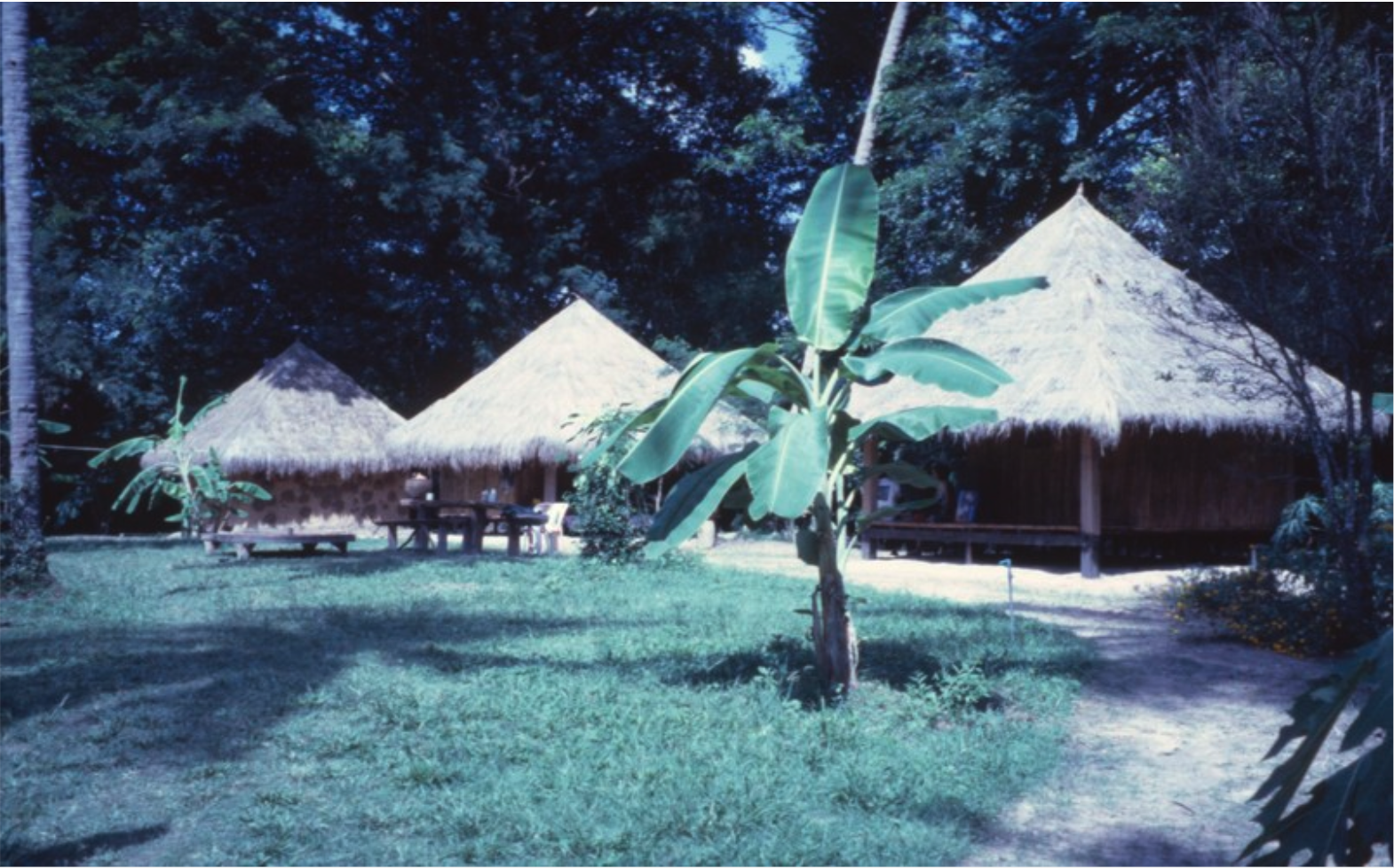
The art-school-trained artists and the local craftspeople established informal processes of collaboration both in a large sala and in the space beyond. The sala was a thatched, covered space, with no walls, where multiple activities took place each day.
On the cemented floor the weaver Pann Parahom worked off a floor loom. Along with local weavers, she interlaced long cotton threads passing in one direction with others at a right angle to them forming complex, geometric learnt patterns. Weaving is a method of textile production in which the longitudinal threads are called the warp and the lateral threads are the weft or filler. The method the weaver selects in interweaving these threads influences the characteristic of the cloth. The threads are held by a loom generally constructed from wood or metal to support the threads and determine the size of the fabric.
I found myself embroiled deep into the process too, showing one of the artists and co-organisers, Preenun Nana how to assemble a makeshift bamboo frame loom, on which she proceeded to weave interconnected elements of plant and fabric. We spoke of the use of approaches involving simpler methods that made reference to the Palaeolithic era and recognised the 27,000-year history of weaving.
In another part of the sala sat an elderly basket-weaver crafting an exquisite self-contained, palm-sized basket. Behind him, displayed on trestle tables, was an array of his baskets for us to study at our leisure, much like a museum display.
A basket is worked from a base upwards to contain side walls and a rim. It may have a lid, handle and embellishments. It is a utilitarian, three-dimensional article that performs multiple tasks.
The static base can be woven with reed, willow or bamboo amongst other plant fibres in a variety of shapes to change the size or placement of particular styles of weaving. These upright lengths are referred to as spokes, stakes or staves. Weavers also used fillers. Methods of weaving that are involved in fabric-weaving can be used in basket-weaving as well. Coiling, plaiting, twining and splint basketry are the four known types of weaving found in basket-weaving.
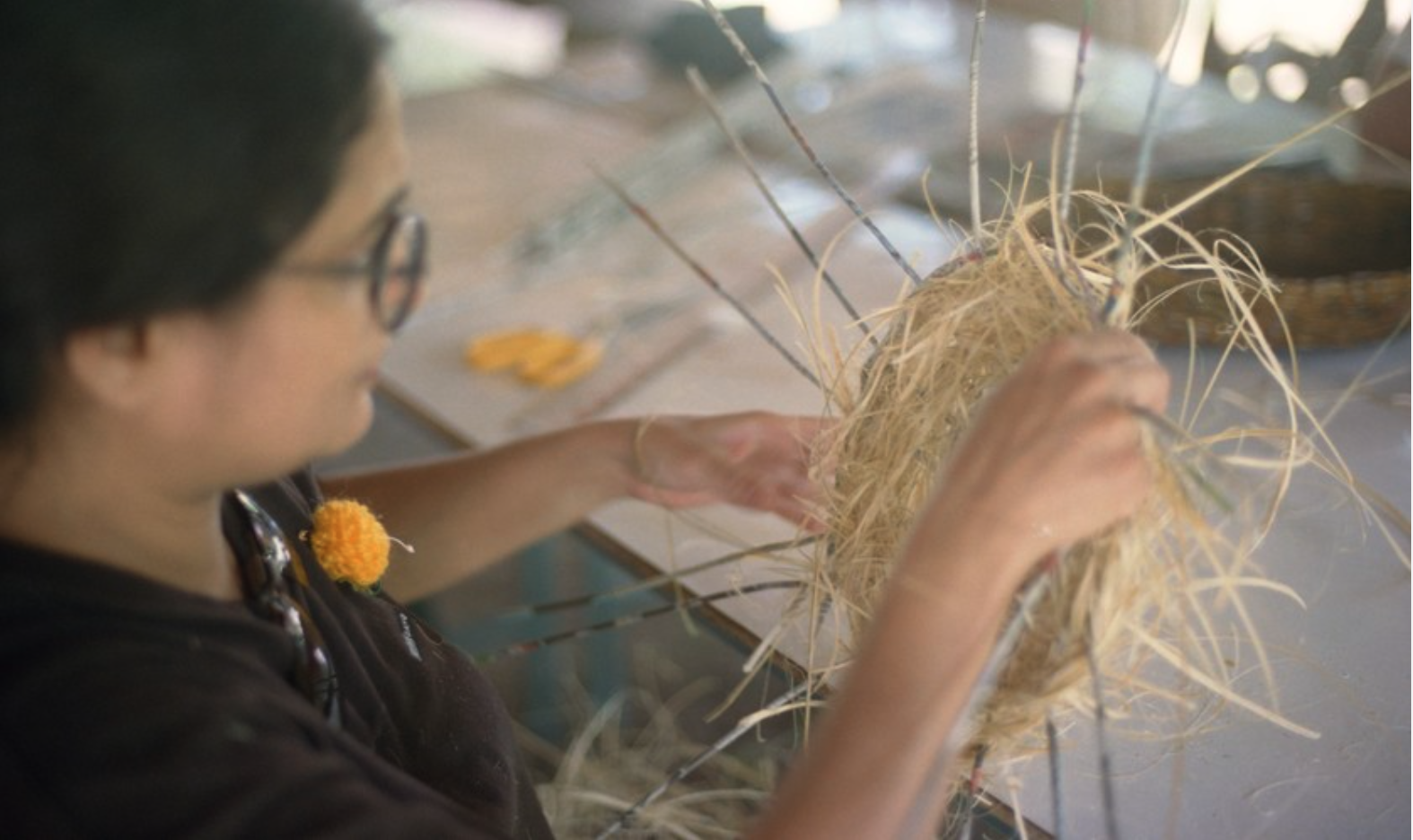
Baskets have been constructed from perishable materials for as long as societies have existed, with evidence found through carbon-dated technology in the Middle East used in two sites from the Pre-Pottery Neolithic period: Tell Sabi Abyad and Catalhoyuk, 10,000 and 12,000 years old, respectively.
The most common evidence of basketry is an imprint of the weave on fragments of clay pots, formed by packing on the walls of the basket and firing. With no prior knowledge regarding any type of basket- or cloth-weaving, Nitaya was to undertake a collaboration with a local basket-weaver, Khun Promma, to produce a sculptural object. Explaining to a seasoned basket-weaver who wove baskets to ensnare fish how to adapt his methodology for a less conventional output that lacked the practical usage of the traditional fishing baskets was not an easy task. The language of objects carried down through generations had instilled in him the functionality of the article, and not necessarily its aesthetic content nor an understanding of the underlying concepts. Nitaya drew on the terminology of decorative items in her explanation for her reticent collaborator Khun Promma. Ultimately, we succeeded in reaching an understanding, using a series of drawings Nitaya especially executed for this process.

Sinking onto the floor of the sala, Nitaya began the process of constructing an object, by cutting and paring bamboo to create its material content of stakes and weft. A learning process took place for both the artist and the artisan. Nitaya learnt to weave and construct with traditional materials, making decisions to shape, lengthen, decrease or increase the stakes to shape the object. The final outcome carried two distinct histories: one of the craftsperson and the other of the art-school-trained artist who successfully combined traditional methods with her conceptual thinking to continue a tradition that is at risk of disappearing.
The exchange of ideas not only reflected in us adopting and applying learnt methodologies; we were also introduced to Thailand’s cultural facets on the farm. In walked a group of serene monks early one morning, and we sat in bare feet, in single file, on a mud path, bowing to them with folded palms and offering flowers and food in its various forms—an alien custom for an outsider, but an honoured religious tradition for our hosts.
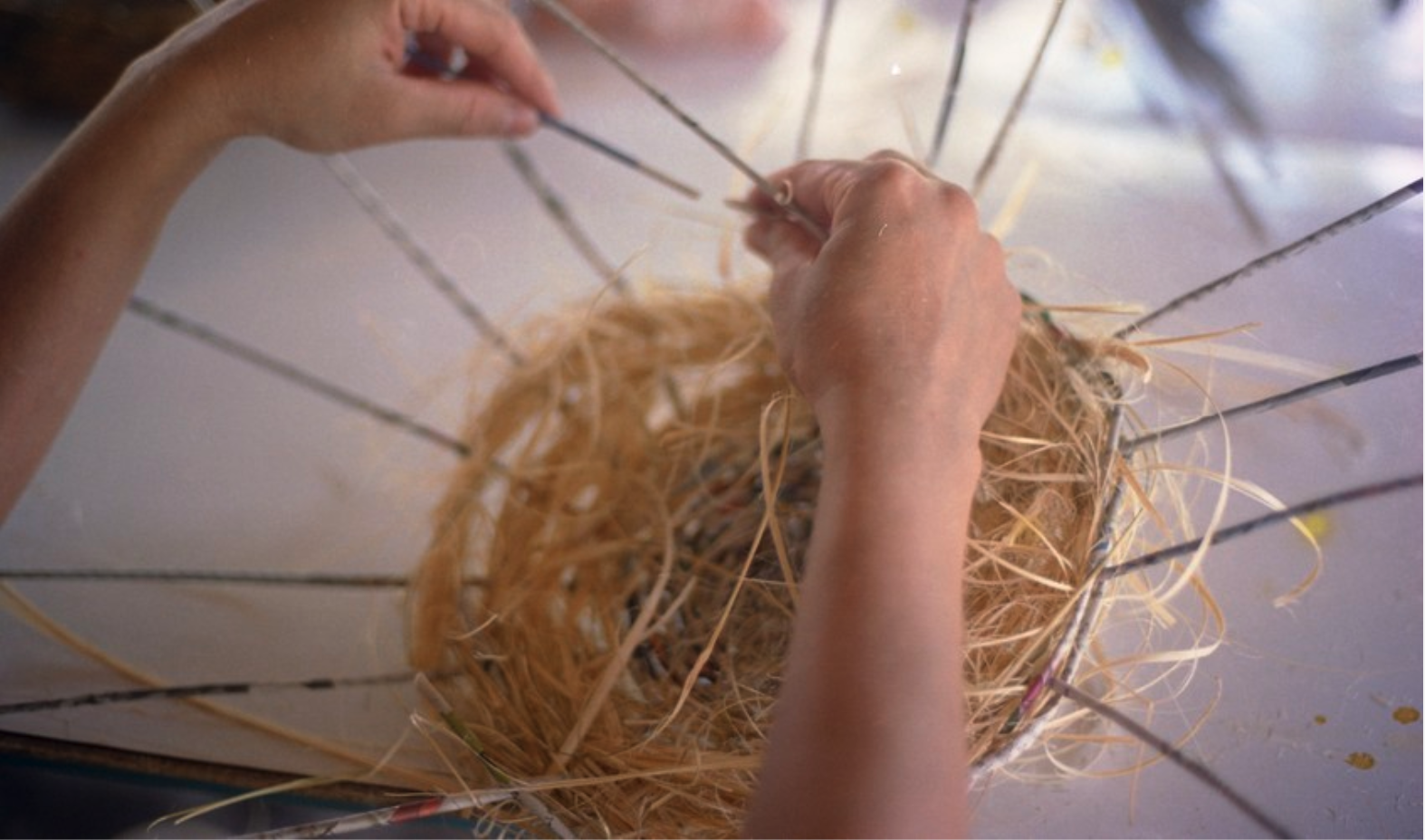
On another day we prepared floats with sliced banana trunks, folded leaves, flowers, sparklers and candles. At our hosts’ behest we laboured away during the day, urged on by the local women who demonstrated the assemblage of these unique objects. It was Loy Krathong, or the festival of light, when Thais pray to the water goddess Mae Khongkha as they send their decorated boats down a water body. With lit sparklers in our hands we walked through the full-moon night towards the stream. We gently placed our sensitively prepared floats on the water to float away, taking our dreams and desires into the wilderness of the night and invoking Mae Khongkha, with the moon as our only witness.
The artist Narumol’s created a site-specific installation referring to Loy Krathong in a wattle and daub hut. Its interior and exterior facade glowed with candles strategically placed in holes created in the walls of the hut with clay. At a distance these protuberant and breast-like lit cells enveloped us in their warmth. Narumol walked into the cavernous womb space performing, narrating Pann Parahom’s family’s herstory in homage to our hostess as candles were lit in the space. Women’s spaces were being demarcated and acknowledged. Once more one saw the overlapping of the trained artist and craftsperson and the two becoming indivisible.
Each night we collected in the large sala to present our works and dialogue with our peers, alongside the four co-organisers of this project who oversaw the proceedings.
The Thai curator Naomi Urabe, who at the time was based in New York at Art in General, had previously been a curator in residence at About Cafe in Bangkok, where she planned events for two years as there were very few curated art events in Thailand at that point. During the workshop she circulated amongst the artists and craftspeople, questioning our motivations as we processed our thoughts, often catching us off guard, forcing us to put on our thinking caps on before we responded. An anecdote followed Urabe: a chicken on the farm had taken a shine to her and diligently laid an egg each day on her bed.
Among our party was Varsha Nair, an Indian artist based in Thailand, whose heritage of skill-based artisan communities is similar to the group of artisans we were working with. Her contribution to the workshop was to act as a catalyst putting different categories of people together to extend two different thought processes and initiate a dialogue that was intended to go far beyond this particular workshop.
Varsha participated in the workshop as well, and dyed paper using Pann Parahom’s dye pot to create an installation around a tree on the farm. She videotaped the installation by strategically placing her camera at knee level to capture the lemongrass bushes behind the kitchen, using the visual medium to also to capture the sounds and smells of the farm—the impact of which would linger outside of this reflective moment.
Having mentioned dyes one can jump in with, Pann Parahom demonstrated the dye preparation method with the areca nut that grows on her farm. This species of nut is known for its bitter and tangy taste, raw and dried form. Commonly chewed in combination with the betel leaves and dried tobacco leaves, it grows in Melanesia and Micronesia, Southeast Asia, south Asia and parts of east Africa.
Pann Parahom not only chewed the areca nut but also used it to dye her yarn to weave magical patterns into her fabric. Witnessing the pounding of this hard nut in a large wooden mortar with a huge wooden pestle made us question the strength of this slightly built woman who pulverised it rapidly, adding water periodically to create a bath for her yarn. We added a mordant of salts to bind the dyes and beat it into the yarn, and hung it out to dry, to be eventually woven by herself, as we had already discovered.
All our activities were bound to make us very thirsty. A drink in the form of rice wine—a sake—was prepared by our hosts using boiled rice, yeast and water that was to be preserved in a large jar and covered with a muslin to mature. Naturally we could not drink it at that point, but we had Prenun provide an excellent service by translating the ins and outs of sake creation. It was an illegal activity: by law one could not make it in one’s household. This was not a dry country, but the wealthy mafia controlled the factories and the sale of alcohol.
If that was not enough, we made a day trip to a temple on the Thailand–Cambodia border. Dense vegetation covered the area as far as the eye could see. It was an unmanned border, with IEDs strategically placed by the Khmer Rouge in the 1970s. We relaxed with our picnic and took in the picturesque view from a great distance.
On our way back we made a trip to the bazaar to view the local produce—fruit and vegetables. Some of the produce was delivered to the farm for our consumption, as the farm itself did not grow the vast varieties of produce that could be found at the market. The kitchen on the farm was run by Pann Parahom’s sister and thrice a day we were served exquisite Thai cuisine. What a treat. What extraordinary hospitality!
Pann Parahom’s contacts were widespread in her community. We were regaled by the Mulam singers one evening in the main sala. Merrily we joined in with the dancing and singing whilst they played on their bamboo Khaen pipes that reminded us of South American pan pipes. They sang about their day-to-day lives of fishing and farming, and their lost loves. Modernisation is leading to the synthesis of these ancient instruments with contemporary instruments and methods of rendition. Perhaps we were lucky participants of the last of these ancient traditions that have been meticulously documented for posterity over many generations by the local craftspeople, much in the manner an anthropologist would have used in their bid to preserve disappearing cultures.
Our 10 days sadly were coming to an end. We had made new friends and had lived together harmoniously in a great spirit of camaraderie. The farm had rung with our laughter and conversations time and time again. Made work, didn’t make work.
Nilofar Akmut is is an artist, performer and poet born in London and raised in Pakistan, presently based in London. She has studies at numerous institutions: the NCA in Lahore, Pakistan; Byam Shaw school of Art; Slade School of Art; and the Royal Holloway in the U.K Akmut has also collaborated on several projects with the renowned artist Jo Spence. Her exhibitions span across various international venues including Transition of Riches (Birmingham Museum, U.K.); DWOTIS (Fukuoka Museum of Asian Art, Japan); IFOOFMB (Setayaga Museum, Japan); Subjected Culture (Argentina); Flames (Germany); Dhaka Biennale (Bangladesh); Womanifesto (Thailand Germany); T. Southeast Asia Triennial (China); Lahore Biennale (Pakistan); and Slaughterhouse (U.K.).
Related pages
Share a Reflection
log in to share a reflection.
